Use of Phenomics in the Selection of UAV-Based Vegetation Indices and Prediction of Agronomic Traits in Soybean Subjected to Flooding
Abstract
1. Introduction
2. Materials and Methods
2.1. Experimental Design
2.2. Field Evaluations
2.3. Image Acquisition Using UAV
2.4. Statistical Analysis
3. Results
3.1. Analysis of Variance Components
3.2. Best Linear Unbiased Prediction (BLUP) Analysis
4. Discussion
5. Conclusions
- The environmental factor exerts a significant influence on vegetation indices, which limits their large-scale use in characterizing soybean genotypes with differential tolerance to flooding using multispectral sensors embedded on unmanned aerial vehicles.
- The phenomic analysis was efficient for identifying vegetation indices with greater heritability, accuracy, and genetic variation, namely, MSAVI, NDVI, SAVI, OSAVI, VEG, MGRVI, EVI2, GRVI, RGBindex, EXG, NDB, and HEI_e. These variables can be used in subsequent studies to develop predictive models of agronomic variables linked to the response of soybeans to flooding with high accuracy.
- The methodology based on RELM-BLUP for characterizing the behavior of each spectral variable depending on the environment and evaluated genotypes allows the identification of predictors (IVs) with greater genetic heritability and their use in the selection of soybean genotypes tolerant to flooding.
- Variables predicted based on the use of genetic data estimated via phenomics presented a coefficient of determination above 0.90 and allow the reduction in the number of important variables within the linear model of prediction.
Author Contributions
Funding
Data Availability Statement
Acknowledgments
Conflicts of Interest
References
- Montoya, F.; García, C.; Pintos, F.; Otero, A. Effects of irrigation regime on the growth and yield of irrigated soybean in temperate humid climatic conditions. Agric. Water Manag. 2017, 193, 30–45. [Google Scholar] [CrossRef]
- Sun, J.; Mooneyc, H.; Hu, W.; Tang, H.; Tong, Y.; Xu, Z.; Huang, B.; Cheng, Y.; Yang, X.; Wei, D.; et al. Importing food damages domestic environment: Evidence from global soybean trade. Proc. Natl. Acad. Sci. USA 2018, 115, 5414–5419. [Google Scholar] [CrossRef] [PubMed]
- Song, X.P.; Hansen, M.C.; Potapov, P.; Adusei, B.; Pickering, J.; Adami, M.; Lima, A.; Zalles, V.; Stehman, S.V.; Di Bella, C.M.; et al. Massive soybean expansion in South America since 2000 and implications for conservation. Nat. Sustain. 2021, 4, 784–792. [Google Scholar] [CrossRef] [PubMed]
- Finoto, E.L.; Soares, M.B.B.; Correia, A.N.; Albuquerque, J.A.A.; Silva, E.S. Sowing times in adaptation, stability, yield, and oil and protein contents of soybean genotypes. Rev. Caatinga 2021, 34, 799–812. [Google Scholar] [CrossRef]
- Zanon, A.J.; Silva, M.R.; Tagliapietra, E.L.; Cera, J.C.; Bexaira, K.P.; Richter, G.L.; Duarte, A.J.; Rocha, T.S.M.; Weber, P.S.; Streck, N.A. Ecofisiologia da Soja: Visando Altas Produtividades, 1st ed.; Palloti: Santa Maria, Brasil, 2018; pp. 1–136. [Google Scholar]
- Ye, H.; Song, L.; Chen, H.; Valliyodan, B.; Chen, P.; Ali, L.; Vuong, T.; Wu, C.; Orlowski, J.; Buckley, B.; et al. A major natural genetic variation associated with root system architecture and plasticity improves waterlogging tolerance and yield in soybean. Plant Cell Environ. 2018, 41, 2169–2182. [Google Scholar] [CrossRef]
- Fletcher, E.; Patterson, R.; Dunne, J.; Saski, C.; Fallen, B. Evaluating the effects of flooding stress during multiple growth stages in soybean. Agronomy 2023, 13, 1243. [Google Scholar] [CrossRef]
- Reynolds, M.; Chapman, S.; Crespo-Herrera, L.; Molero, G.; Mondal, S.; Pequeno, D.N.L.; Pinto, F.; Pinera-Chavez, F.J.; Poland, J.; Rivera-Amado, C.; et al. Breeder friendly phenotyping. Plant Sci. 2020, 295, 110396. [Google Scholar] [CrossRef]
- Xie, C.; Yang, C. A review on plant high-throughput phenotyping traits using UAV-based sensors. Comp. Electron. Agric. 2020, 178, 105731. [Google Scholar] [CrossRef]
- Gill, T.; Gill, S.K.; Saini, D.K.; Chopra, Y.; Koff, J.P.; Sandhu, K.S. A comprehensive review of high throughput phenotyping and machine learning for plant stress phenotyping. Phenomics 2022, 2, 156–183. [Google Scholar] [CrossRef]
- Bannari, A.; Morin, D.; Bonn, F. A review of vegetation indices. Remote Sens. Rev. 1995, 13, 95–120. [Google Scholar] [CrossRef]
- Khan, Z.; Rahimi-Eichi, V.; Haefele, S.; Garnett, T.; Miklavcic, S.J. Estimation of vegetation indices for high throughput phenotyping of wheat using aerial imaging. Plant Methods 2018, 14, 20. [Google Scholar] [CrossRef] [PubMed]
- Santana, D.D.; Cunha, M.P.O.; Santos, R.G.; Cotrim, M.F.; Teodoro, L.P.R.; Júnior, C.A.S.; Baio, F.H.R.; Teodoro, P.E. High throughput phenotyping allows the selection of soybean genotypes for earliness and high grain yield. Plant Methods 2022, 18, 13. [Google Scholar] [CrossRef] [PubMed]
- Bai, D.; Li, D.; Zhao, C.; Wang, Z.; Shao, M.; Guo, B.; Liu, Y.; Wang, Q.; Li, J.; Guo, S.; et al. Estimation of soybean yield parameters under lodging conditions using RGB information from unmanned aerial vehicles. Front. Plant Sci. 2022, 13, 1012293. [Google Scholar] [CrossRef] [PubMed]
- Randelovic, P.; Dordevic, V.; Miladinovic, J.; Prodanivic, S.; Ceran, M.; Vollmann, J. High-throughput phenotyping for non-destructive estimation of soybean fresh biomass using a machine learning model and temporal UAV data. Plant Methods 2023, 19, 89. [Google Scholar] [CrossRef] [PubMed]
- Olivoto, T.; Lúcio, A.D.C.; Silva, J.A.G.; Sari, B.G.; Diel, M.I. Mean performance and stability in multi-environment trials ii: Selection based on multiple traits. Agronomy J. 2019, 111, 2961–2969. [Google Scholar] [CrossRef]
- Loro, M.V.; Carvalho, I.R.; Filho, A.C.; Hoffmann, J.F.; Kehl, K. Wheat grain biofortification for essential amino acids. Pesq. Agropec. Bras. 2023, 58, e02860. [Google Scholar] [CrossRef]
- Rutkoski, J.; Poland, J.; Mondal, S.; Autrique, E.; Pérez, L.G. Canopy temperature and vegetation indices from high-throughput phenotyping improve accuracy of pedigree and genomic selection for grain yield in wheat. G3 Genes 2016, 6, 2799–2808. [Google Scholar] [CrossRef]
- Kehl, K.; Carvalho, I.R.; Sacon, D.; Rizzardi, M.A.; Langaro, N.A.; Loro, M.V.; Moura, N.B.; Lautenchleger, F. Strategic positioning of soybean based on the agronomic ideotype and on fixed and mixed multivariate models. Pesq. Agropec. Bras. 2022, 57, e02702. [Google Scholar] [CrossRef]
- Carvalho, I.R.; Szareski, V.J.; Mambrin, R.B.; Ferrari, M.; Pelegrin, A.J.; Rosa, T.C.; Peter, M.; Silveira, D.C.; Conte, G.G.; Barbosa, M.H.; et al. Biometric models and maize genetic breeding: A review. Aust. J. Crop Sci. 2018, 11, 1796–1805. [Google Scholar] [CrossRef]
- Nguyen, T.V.; Vuong, T.D.; Vantoai, T.; Lee, J.D.; Wu, X.; Mian, M.A.R.; Dorrance, A.E.; Shannon, J.G.; Nguyen, H.T. Mapping of quantitative trait loci associated with resistance to Phytophthora sojae and flooding tolerance in soybean. Crop Sci. 2012, 52, 2481–2493. [Google Scholar] [CrossRef]
- Pradebon, L.C.; Carvalho, I.R.; Da Silva, J.A.G.; Loro, M.V.; Pettenon, A.L.; Roza, J.P.D.; Da Silva, T.B. Selection based on the phenomenic approach and agronomic ideotic of white oat. Agronomy J. 2024, 116, 1275–1289. [Google Scholar] [CrossRef]
- Olivoto, T.; Lúcio, A.D. Metan: An R package for multi-environment trial analysis. Methods Ecol. Evol. 2020, 11, 783–789. [Google Scholar] [CrossRef]
- Zhou, J.; Mou, H.; Zhou, J.; Ali, M.L.; Ye, H.; Chen, P.; Nguyen, H.T. Qualification of soybean responses to flooding stress using uav-based imagery and deep learning. Plant Phenomics 2021, 2021, 9892570. [Google Scholar] [CrossRef] [PubMed]
- Adegoye, G.A.; Olorunwa, O.J.; Alsajri, F.A.; Walne, C.H.; Wijewandana, C.; Kethireddy, S.R.; Reddy, K.N.; Reddy, K.R. Waterlogging effects on soybean physiology and hyperspectral reflectance during the reproductive stage. Agriculture 2023, 13, 844. [Google Scholar] [CrossRef]
- Bernardo, R. Reinventing quantitative genetics for plant breeding: Something old, something new, something borrowed, something BLUE. Heredity 2020, 125, 375–385. [Google Scholar] [CrossRef]
- Wang, Y.; Vik, J.O.; Omholt, S.W.; Gjuvsland, A.B. Effect of regulatory architecture on broad versus narrow sense heritability. PLoS Comput. Biol. 2013, 9, e1003053. [Google Scholar] [CrossRef]
- Resende, M.D.V.; Duarte, J.B. Precision and quality control in cultivar evaluation experiments. Pesq. Agropec. Trop. 2007, 37, 182–194. [Google Scholar]
- Flint-Garcia, S.A.; Thuillet, A.C.; Yu, J.; Pressoir, G.; Romero, S.M.; Mitchell, S.E.; Doebley, J.; Kresovich, S.; Goodman, M.M.; Buckler, E.S. Maize association population: A high-resolution platform for quantitative trait locus dissection. Plant J. 2005, 44, 1054–1064. [Google Scholar] [CrossRef]
- Olivoto, T.; Nardino, M.; Carvalho, I.R.; Follman, D.N.; Ferrari, M.; Szareski, V.J.; Pelegrin, A.J.; Souza, V.Q. REML/BLUP and sequential path analysis in estimating genotypic values and interrelationships among simple maize grain yield-related traits. Genet. Mol. Res. 2018, 16, gmr16019525. [Google Scholar] [CrossRef]
- Alcântara, J.F.; Santos, R.G.; Baio, F.H.R.; Júnior, C.A.S.; Teodoro, P.E.; Teodoro, L.P.R. High-throughput phenotyping as an auxiliary tool in the selection of corn hybrids for agronomic traits. Rev. Ceres 2023, 70, 106–113. [Google Scholar] [CrossRef]
- Oliveira, J.F.; Alcântara, J.F.; Santana, D.C.; Teodoro, L.P.R.; Baio, F.H.R.; Coradi, P.C.; Junior, C.A.d.S.; Teodoro, P.E. Spectral variables as criteria for selection of soybean genotypes at different vegetative stages. Remote Sens. Appl. Soc. Environ. 2023, 32, 101026. [Google Scholar] [CrossRef]
- Lozada, D.N.; Godoy, J.V.; Ward, B.P.; Carter, A.H. Genomic prediction and indirect selection for grain yield in us pacific northwestwinter wheat using spectral reflectance indices from high-throughput phenotyping. Int. J. Mol. Sci. 2020, 21, 165. [Google Scholar] [CrossRef]
- Resende, M.D.V. Software Selegen-REML/BLUP: A useful tool for plant breeding. Crop Breed. Appl. Biotechnol. 2016, 6, 330–339. [Google Scholar] [CrossRef]
- Carvalho, I.R.; Silva, J.A.G.; Ferreira, L.L.; Szareski, V.J.; Demari, G.H.; Lautenchleger, F.; Meneghello, G.E.; Matter, E.M.; Magano, D.A.; De Souza, V.Q. REML/BLUP applied to characterize important agronomic traits in segregating generations of bean (Phaseolus vulgaris L.). Aust. J. Crop Sci. 2020, 14, 391–399. [Google Scholar] [CrossRef]
- Kovar, M.; Brestic, M.; Sytar, O.; Barek, V.; Hauptvogel, P.; Zivcak, M. Evaluation of hyperspectral reflectance parameters to assess the leaf water content in soybean. Water 2019, 11, 443. [Google Scholar] [CrossRef]
- Yang, F.; Liu, S.; Wang, Q.; Liu, T.; Li, S. Assessing waterlogging stress level of winter wheat from hyperspectral imagery based on harmonic analysis. Remote Sens. 2022, 14, 122. [Google Scholar] [CrossRef]
- Ihuoma, S.O.; Madramootoo, C.A. Sensitivity of spectral vegetation indices for monitoring water stress in tomato plants. Comp. Electron. Agric. 2019, 163, 104860. [Google Scholar] [CrossRef]
- Yang, F.; Liu, T.; Wang, Q.; Du, M.; Yang, T.; Liu, D.; Li, S.; Liu, S. Rapid determination of leaf water content for monitoring waterlogging in winter wheat based on hyperspectral parameters. J. Integr. Agric. 2021, 20, 2613–2626. [Google Scholar] [CrossRef]
- Tavares, C.J.; Junior, W.Q.R.; Ramos, M.L.G.; Pereira, L.F.; Casari, R.A.C.; Pereira, A.F.; de Sousa, C.A.F.; da Silva, A.R.; Neto, S.P.d.S.; Mertz-Henning, L.M. Water stress alters morphophysiological, grain quality and vegetation indices of soybean cultivars. Plants 2022, 11, 559. [Google Scholar] [CrossRef]
- Wu, C.; Zeng, A.; Chen, P.; Florez-Palacios, L.; Hummer, W.; Mokua, J.; Klepadlo, M.; Yan, L.; Ma, Q.; Cheng, Y. An effective field screening method for flood tolerance in soybean. Plant Breed. 2017, 136, 710–719. [Google Scholar] [CrossRef]

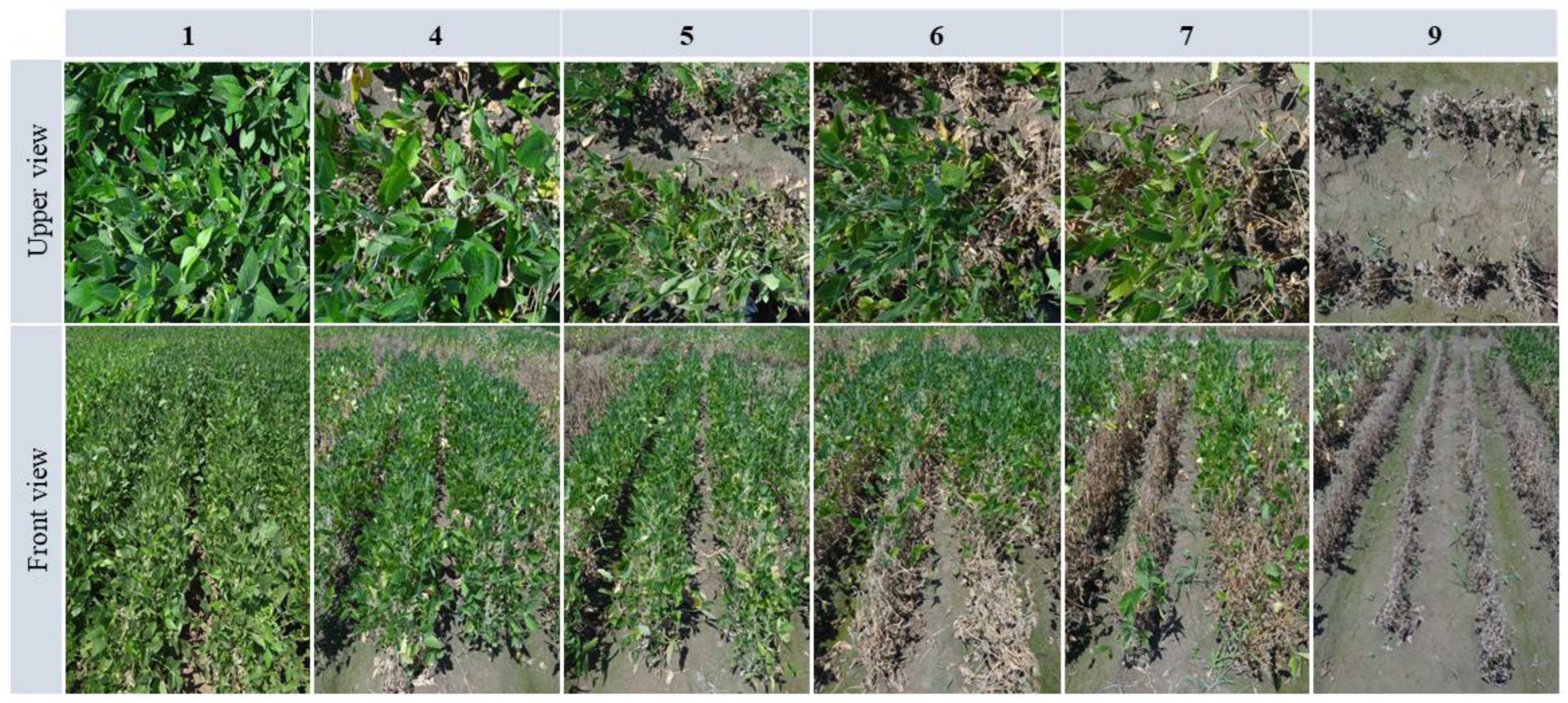
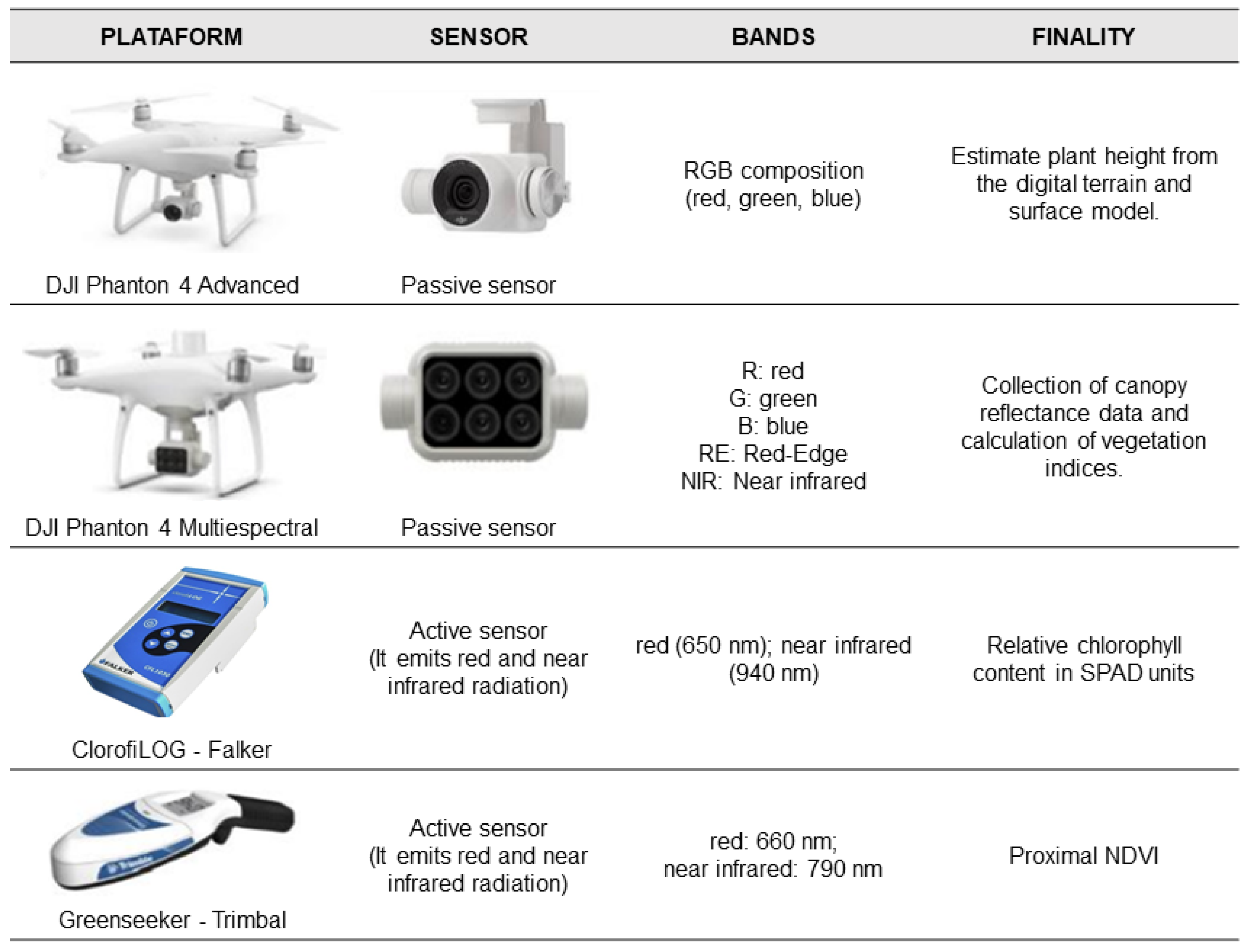
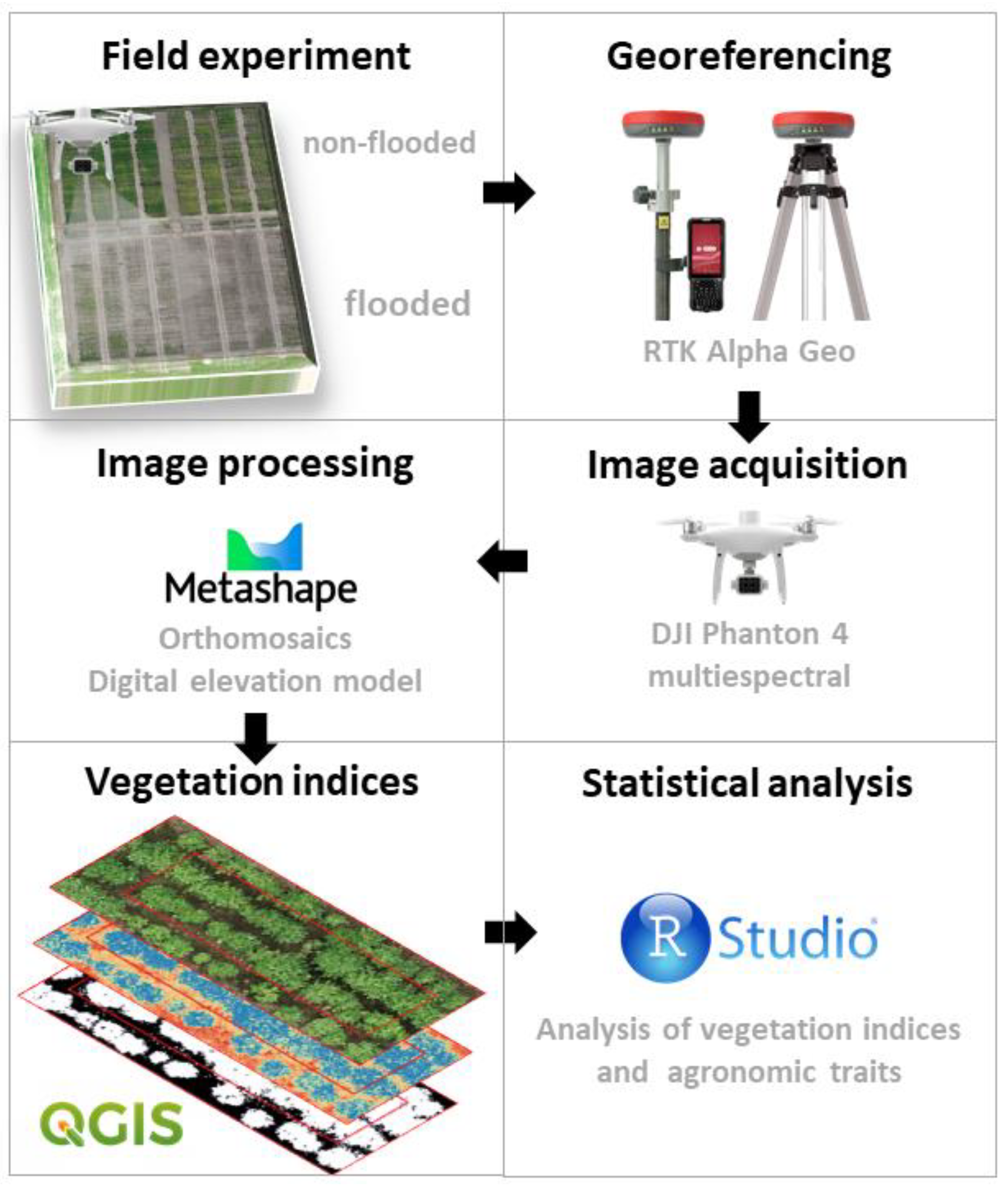
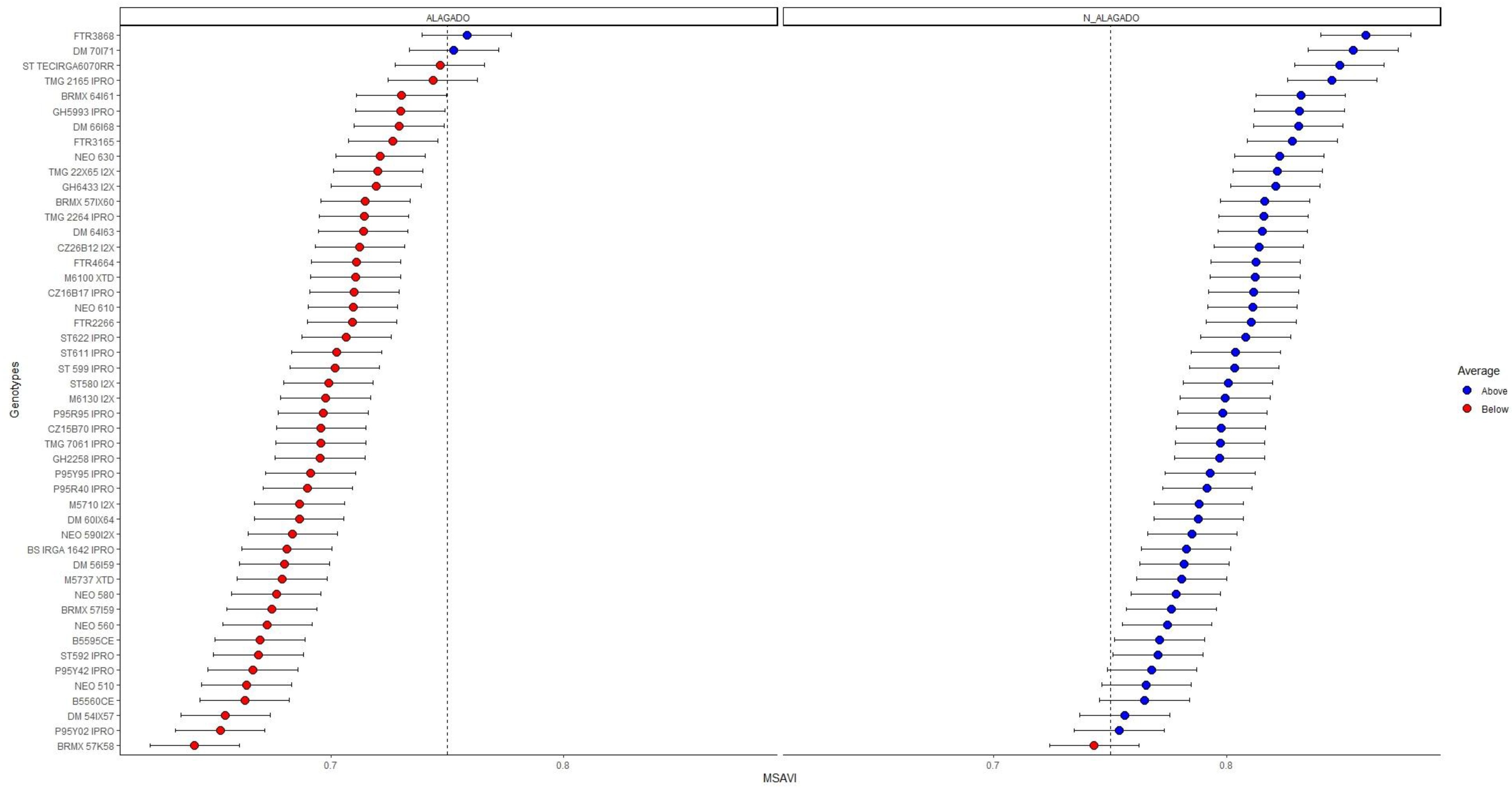

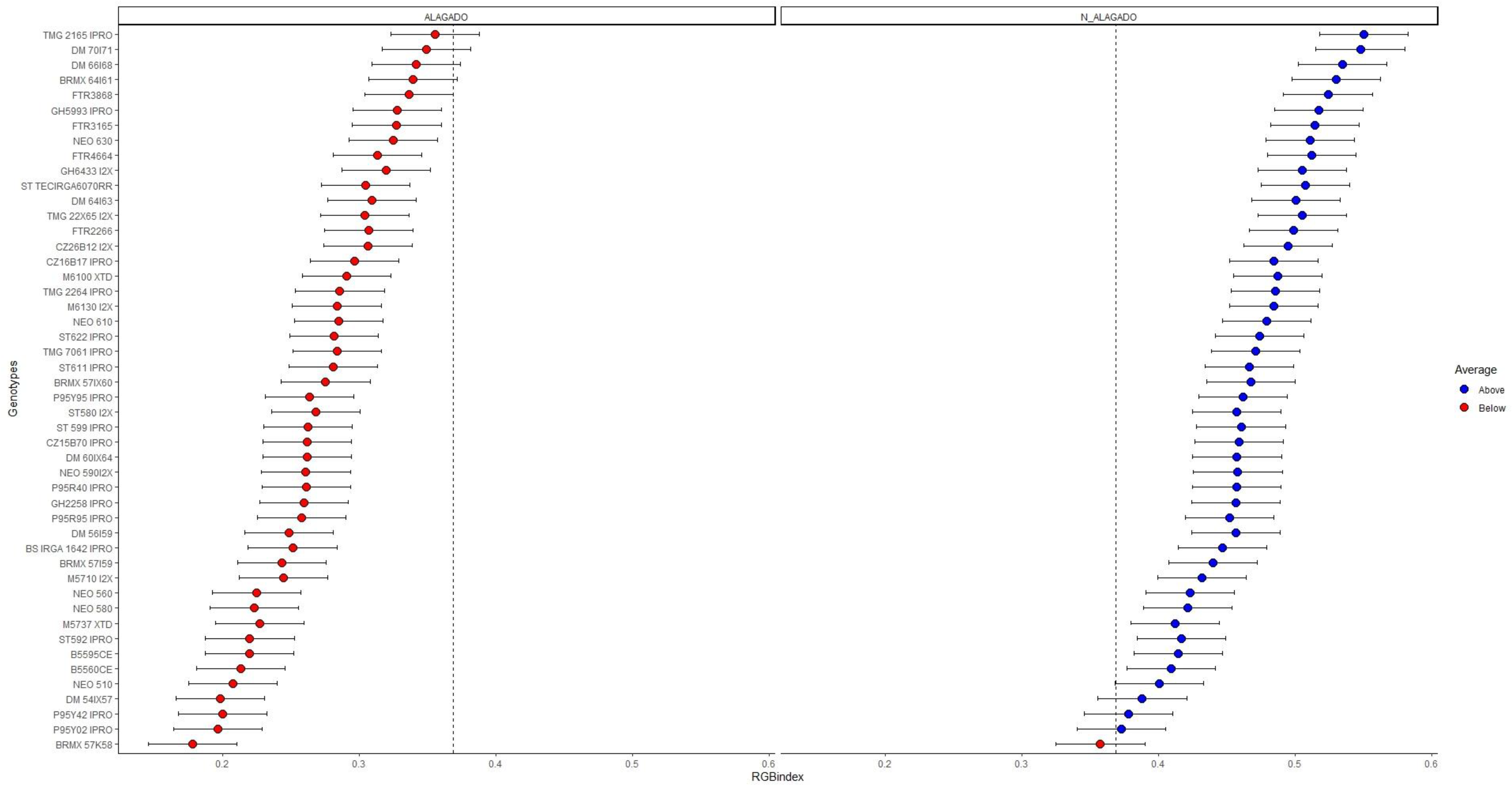
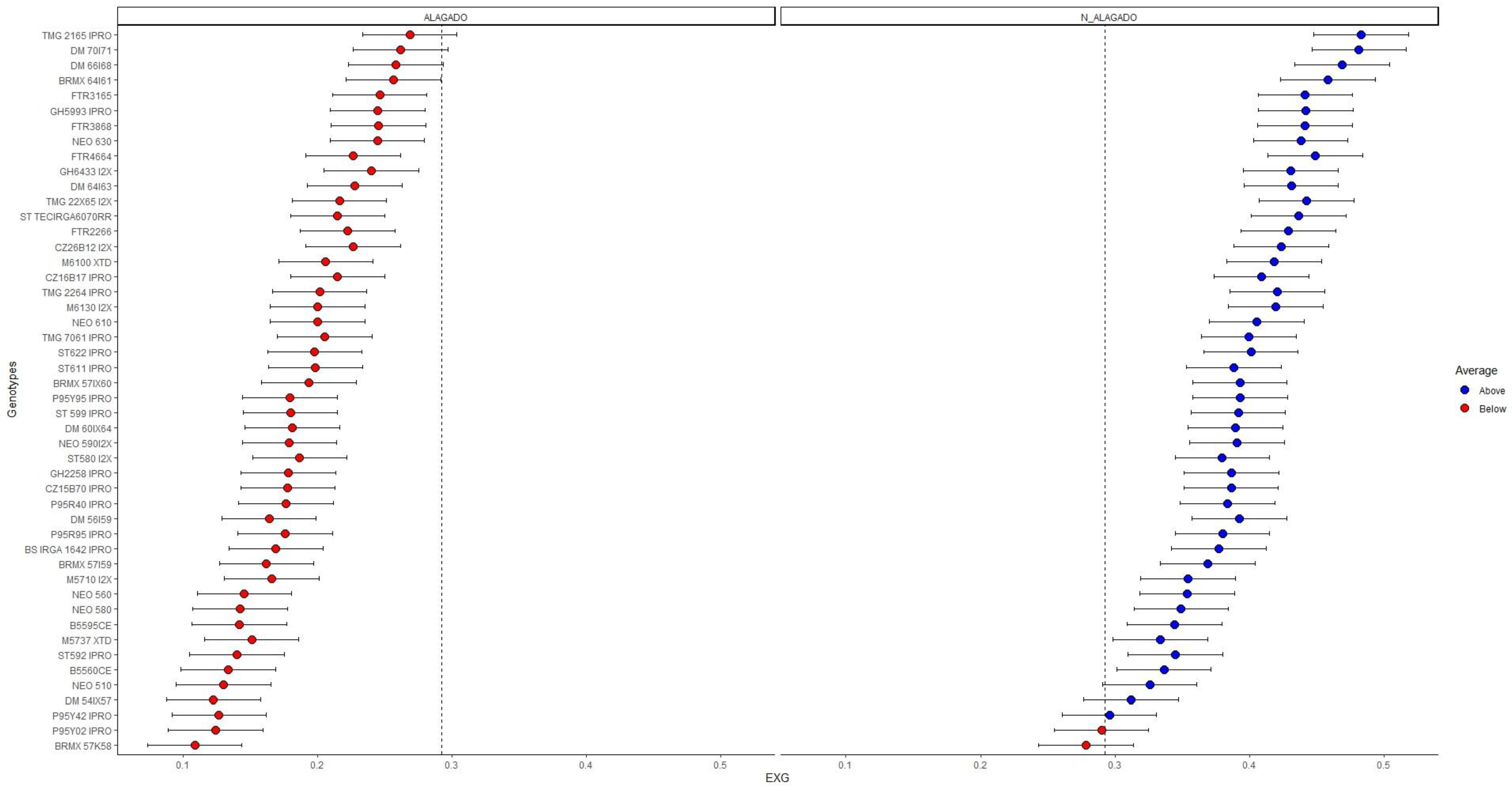
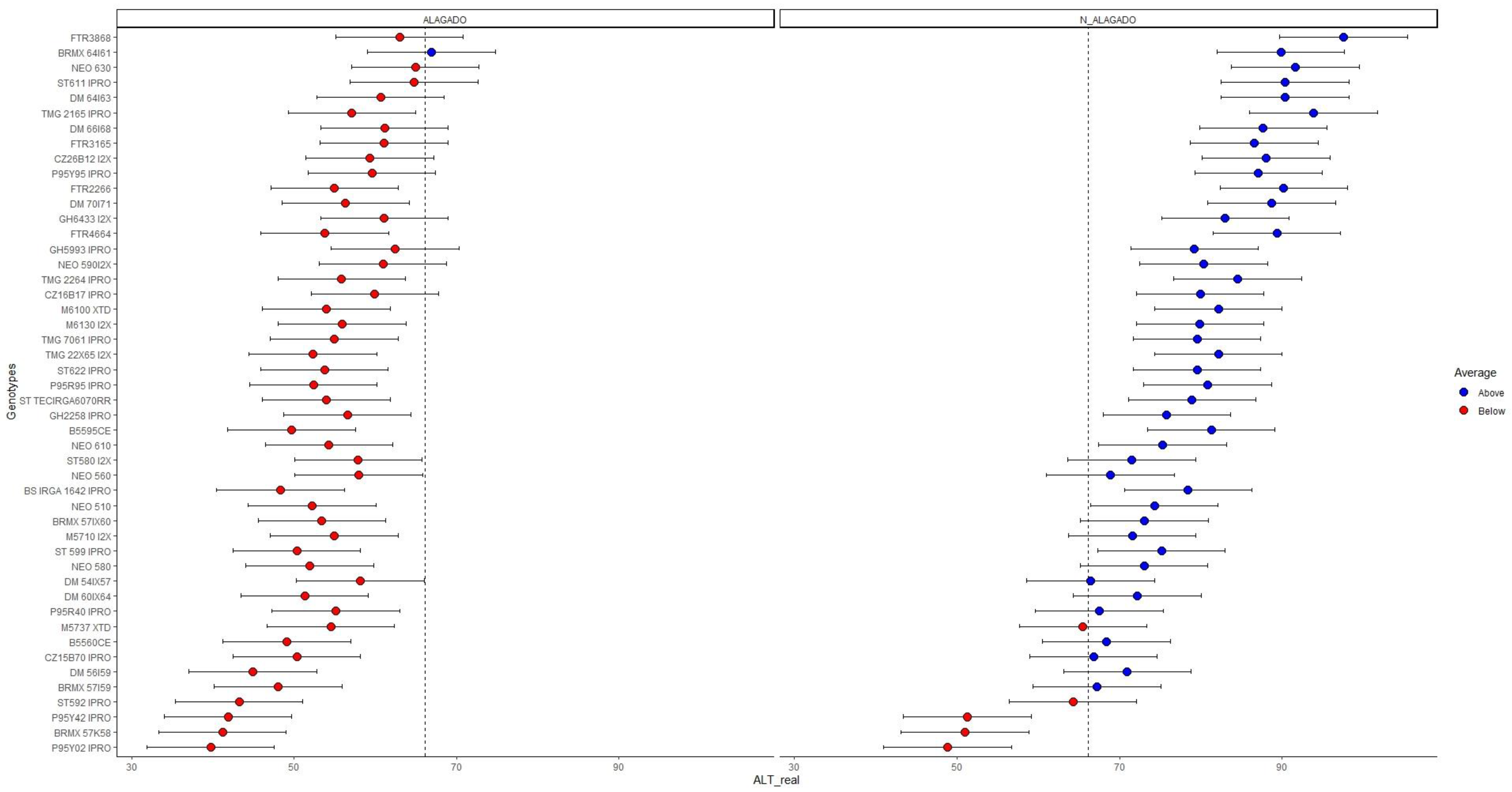
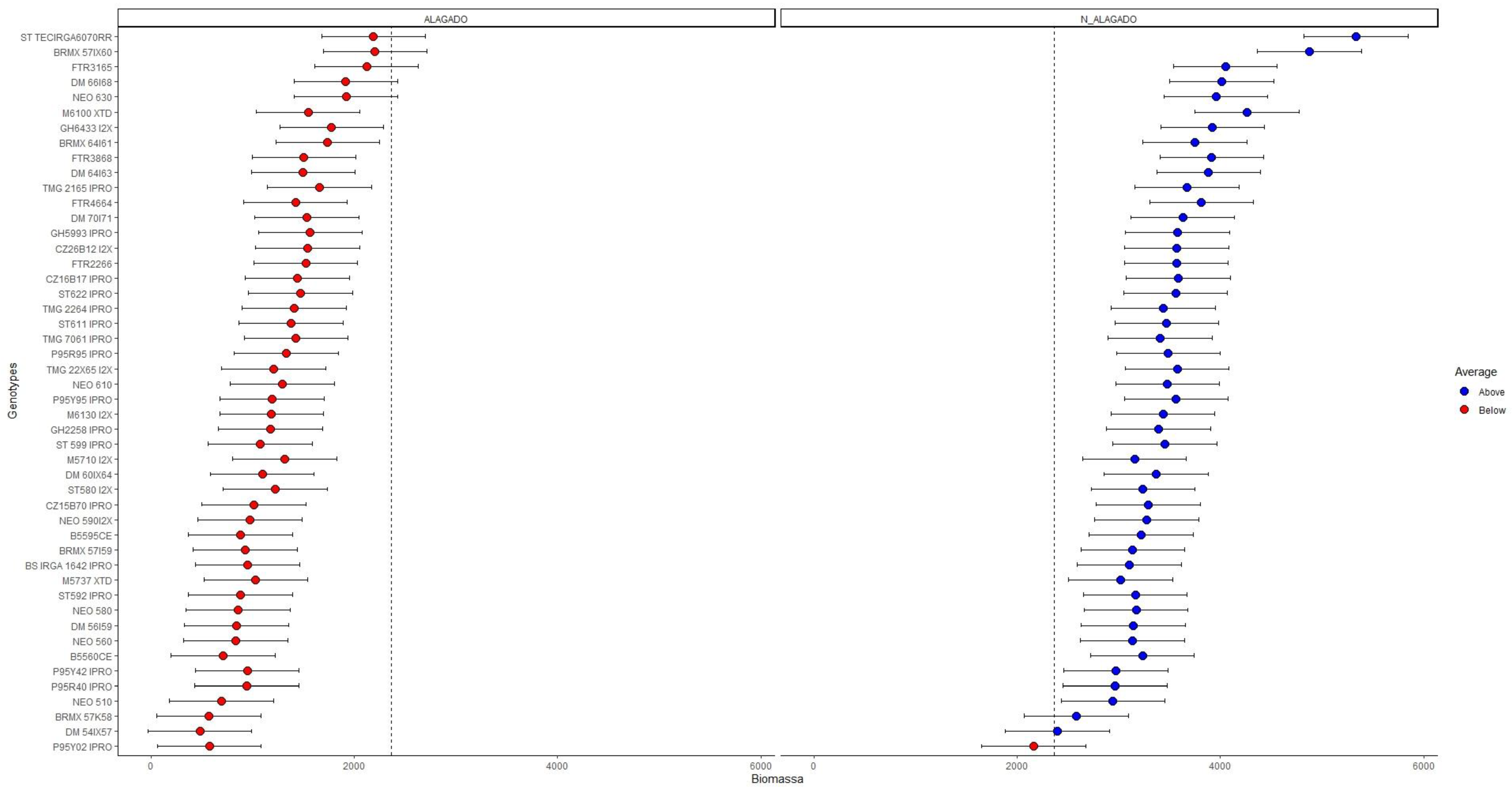
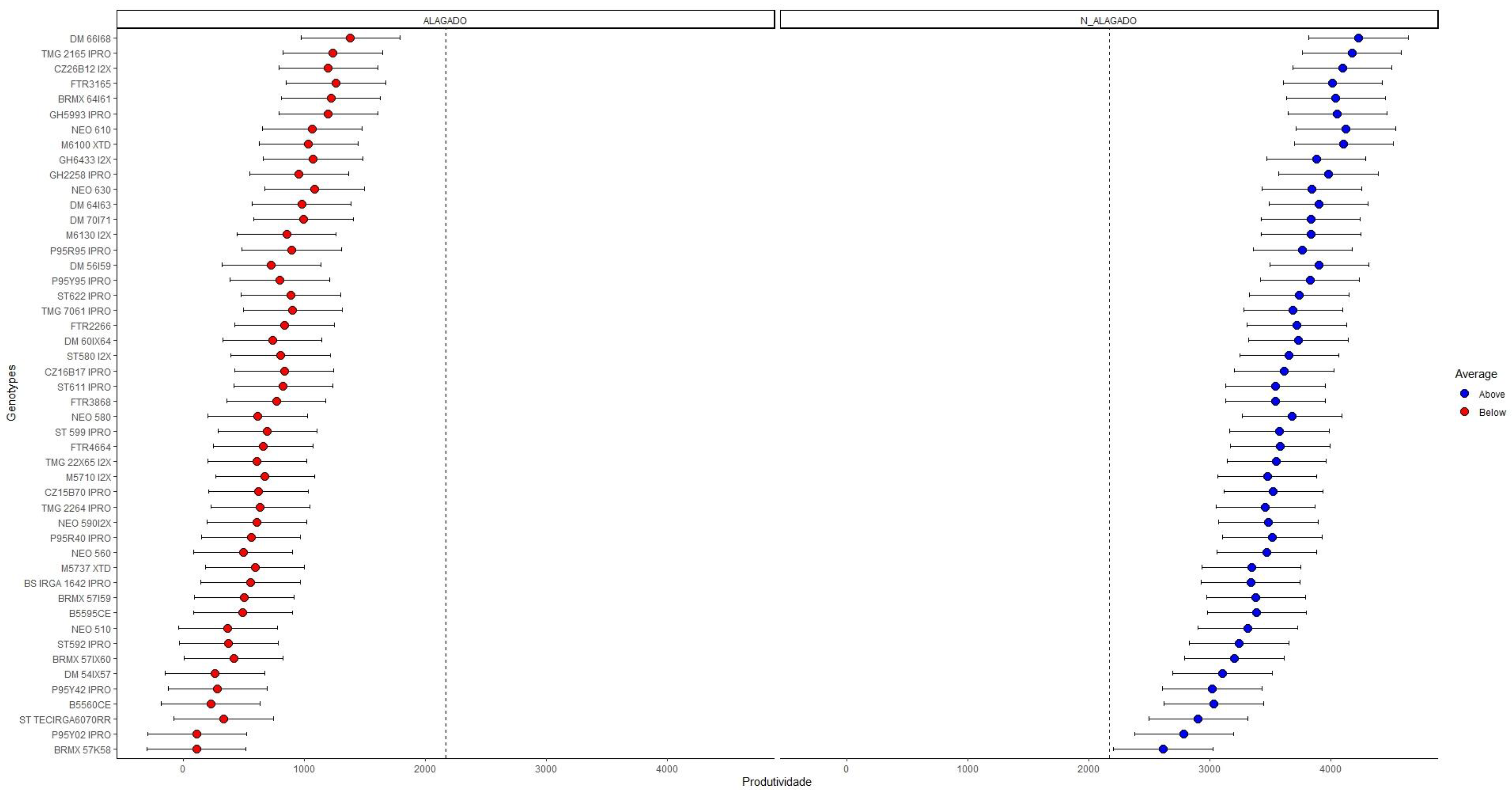

| Type | Index | Equation |
|---|---|---|
| RGB | Excess green | EXG = 2 * (G(R + G + B)) − (R/(R + G + B)) − B/(R + G + B)) |
| Excess raw green | EXGRaw = 2 * G − R − B | |
| Excess red | EXR = (1.4 * R − G)/(R + G + B) | |
| Excess raw red | ExRRaw = 1.4 * R − G | |
| Vegetation extraction color index | CIVE = (0.44 * R − 0.81 * G + 0.39 * B)/(R + G + B) + 18.79 | |
| Normalized green–red index | GRVI = (G − R)/(G + R) | |
| Excess modified red | ExRM = (2 * R − G − B)/(R + G + B) | |
| Vegetative index | VEG = g/((r^a) * (b^(1 − a))) a = 0.667, r = R/(R + G + B), g = G/(G + R + B), b = B/(R + G + B) | |
| Excess blue | ExB = (1.4 * B − G)/(R + G + B) | |
| Normalized blue difference | NDB = (G − B)/(G + B) | |
| Atmospheric resistant index in visible | VARI = (G–R)/(G + R + B) | |
| Green leaf Index | GLI = ((G − R) + (G − B))/(2 * G + R + B) | |
| Triangular green Index | TGI = (−0.5) * [(190) * (R − G) − (120) * (R − B)]/(R + G + B) | |
| Red–blue Index | RBI = (R − B)/(R + B) | |
| Modified green–red index | MGRVI = (G2−R2)/(G2 + R2) | |
| RGB index | RGBindex = (G2 − B * R)/ (G2 + B * R) | |
| MULTISPECTRAL | Normalized difference | NDVI = (NIR − R)/(NIR + R) |
| Edge of red | NDRE = (NIR − RE)/(NIR + RE) | |
| Soil-adjusted index | SAVI = (1 + 0.5) * [(NIR − R)/(NIR + R + 0.5)] | |
| Modified soil-adjusted index | MSAVI = (2 * NIR + 1−sqrt((2 * NIR + 1) * 2–8 * (NIR−R)))/2 | |
| Optimized soil-adjusted index | OSAVI = (1 + 0.5) * ((NIR − R)/(NIR + R + 0.5)) | |
| Improved vegetation index | EVI = 2.5 * (NIR − R)/(NIR + 6 * R − 7.5 * B + 1) | |
| Normalized difference from green | GNDVI = ((NIR − G)/(NIR + G)) | |
| Chlorophyll-green index | CIG = NIR/G − 1 | |
| Red-edge chlorophyll index | CIRE = NIR/RE − 1 | |
| Simple ratio index | RVI = NIR/R | |
| Vegetation difference index | DVI = NIR − R | |
| Green vegetation difference index | GDVI = NIR − G | |
| Green ratio vegetation index | GVI = NIR/G | |
| Vegetation-chlorophyll index | CVI = NIR * (R/G2) | |
| Improved vegetation index 2 | EVI2 = 2.5 * (NIR − R)/(NIR + 2.4 * R + 1) | |
| Normalized blue difference | BNDVI = (NIR − B)/(NIR + B) | |
| R-Re normalized difference | NDVIRE = (RE − R)/(RE + R) | |
| PanNDVI | PanNDVI = NIR − (G + R + B)/NIR + (G + R + B) | |
| Simple NIR/RE ratio | SRNIRRe = NIR/RE | |
| Spectral feature depth | SFDVI = ((NIR + G)/2) − ((R + NIR)/2) |
| Model | HEI_e | HEI_o | Biomass | BNDVI | CHLT | CIG | CIRE |
|---|---|---|---|---|---|---|---|
| Gen | 0.000 | 0.000 | 0.000 | 0.000 | 0.249 | 0.016 | 0.000 |
| G × E | 0.000 | 0.000 | 0.009 | 0.212 | 0.000 | 0.000 | 0.001 |
| Model | CVI | DVI | EVI2 | EXG | EXGRaw | GDVI | GLI |
| Gen | 0.925 | 0.000 | 0.000 | 0.000 | 0.000 | 0.004 | 0.000 |
| G × E | 0.000 | 0.000 | 0.999 | 0.034 | 0.000 | 0.000 | 0.000 |
| Model | GNDVI | GRVI | GVI | MGRVI | MSAVI | N_leaf | NDB |
| Gen | 0.000 | 0.000 | 0.016 | 0.000 | 0.000 | 0.186 | 0.000 |
| G × E | 0.000 | 0.003 | 0.000 | 0.007 | 0.984 | 0.002 | 0.015 |
| Model | NDRE | NDVI | NDVI_G | NDVIRE | OSAVI | PanNDVI | Plants_L |
| Gen | 0.000 | 0.000 | 0.000 | 0.000 | 0.000 | 0.000 | 0.378 |
| G × E | 0.025 | 0.999 | 1.000 | 0.155 | 1.000 | 0.002 | 0.000 |
| Model | Plants_M | TGW | GY | RGBindex | RVI | SAVI | SFDVI |
| Gen | 1.000 | 0.000 | 0.000 | 0.000 | 0.000 | 0.000 | 0.002 |
| G × E | 0.000 | 0.000 | 0.161 | 0.347 | 0.000 | 0.999 | 0.000 |
| Model | SRNIRRe | TGI | VARI | VEG | |||
| Gen | 0.046 | 0.000 | 0.907 | 0.000 | |||
| G × E | 0.000 | 0.000 | 0.000 | 0.000 |
| Parameters | σ2 P | (H2) | GEIr2 | h2mg | Ac | rgloc | CVg | CVe | CVg/ CVe |
|---|---|---|---|---|---|---|---|---|---|
| GLI | 0.00 | 0.35 | 0.23 | 0.67 | 0.82 | 0.36 | 1.03 | 1.14 | 0.91 |
| SRNIRRe | 0.00 | 0.20 | 0.40 | 0.44 | 0.67 | 0.50 | 2.15 | 3.03 | 0.71 |
| VARI | 0.00 | 0.01 | 0.65 | 0.03 | 0.18 | 0.65 | 0.72 | 3.76 | 0.19 |
| MSAVI | 0.00 | 0.49 | 0.00 | 0.88 | 0.94 | 0.00 | 3.79 | 3.86 | 0.98 |
| NDVI | 0.00 | 0.49 | 0.00 | 0.88 | 0.94 | 0.00 | 5.54 | 5.69 | 0.97 |
| OSAVI | 0.00 | 0.49 | 0.00 | 0.88 | 0.94 | 0.00 | 5.54 | 5.69 | 0.97 |
| SAVI | 0.01 | 0.49 | 0.00 | 0.88 | 0.94 | 0.00 | 5.54 | 5.69 | 0.97 |
| VEG | 0.02 | 0.47 | 0.12 | 0.81 | 0.90 | 0.22 | 6.33 | 5.90 | 1.07 |
| NDVIRe | 0.00 | 0.43 | 0.05 | 0.83 | 0.91 | 0.08 | 5.36 | 5.97 | 0.90 |
| TGW | 390.84 | 0.55 | 0.20 | 0.81 | 0.90 | 0.44 | 9.24 | 6.32 | 1.46 |
| GNDVI | 0.00 | 0.36 | 0.15 | 0.72 | 0.85 | 0.24 | 5.60 | 6.57 | 0.85 |
| CVI | 0.03 | 0.01 | 0.62 | 0.03 | 0.16 | 0.62 | 1.12 | 6.89 | 0.16 |
| MGRVI | 0.00 | 0.47 | 0.09 | 0.83 | 0.91 | 0.16 | 7.42 | 7.26 | 1.02 |
| EVI2 | 0.02 | 0.48 | 0.00 | 0.88 | 0.94 | 0.00 | 7.16 | 7.39 | 0.97 |
| NDRE | 0.00 | 0.42 | 0.08 | 0.80 | 0.90 | 0.13 | 6.74 | 7.41 | 0.91 |
| NDVI_G | 0.00 | 0.31 | 0.00 | 0.78 | 0.88 | 0.00 | 5.24 | 7.80 | 0.67 |
| CHL_total | 596.62 | 0.12 | 0.51 | 0.29 | 0.54 | 0.58 | 4.59 | 8.03 | 0.57 |
| HEI_o | 114.19 | 0.46 | 0.30 | 0.72 | 0.85 | 0.56 | 11.2 | 8.09 | 1.39 |
| GRVI | 0.00 | 0.47 | 0.09 | 0.82 | 0.91 | 0.17 | 8.88 | 8.60 | 1.03 |
| BNDVI | 0.01 | 0.42 | 0.04 | 0.83 | 0.91 | 0.07 | 7.81 | 8.81 | 0.89 |
| CIRE | 0.00 | 0.39 | 0.12 | 0.76 | 0.87 | 0.20 | 8.16 | 9.16 | 0.89 |
| Leaf N | 0.25 | 0.18 | 0.27 | 0.48 | 0.69 | 0.33 | 5.53 | 9.53 | 0.58 |
| GVI | 0.34 | 0.24 | 0.36 | 0.51 | 0.71 | 0.47 | 7.93 | 10.3 | 0.77 |
| DVI | 209268.2 | 0.39 | 0.12 | 0.76 | 0.87 | 0.20 | 9.97 | 11.1 | 0.90 |
| RGBindex | 0.00 | 0.52 | 0.03 | 0.88 | 0.94 | 0.05 | 12.9 | 11.9 | 1.07 |
| SFDVI | 29135.1 | 0.29 | 0.29 | 0.59 | 0.77 | 0.41 | 10.2 | 12.3 | 0.83 |
| EXGRaw | 10778.9 | 0.31 | 0.25 | 0.63 | 0.79 | 0.37 | 10.5 | 12.6 | 0.84 |
| GDVI | 315643.7 | 0.27 | 0.30 | 0.58 | 0.76 | 0.41 | 10.9 | 13.6 | 0.80 |
| RVI | 2.05 | 0.40 | 0.17 | 0.74 | 0.86 | 0.29 | 13.7 | 14.1 | 0.97 |
| TGI | 2990.40 | 0.33 | 0.22 | 0.67 | 0.82 | 0.33 | 12.2 | 14.2 | 0.86 |
| CIG | 0.34 | 0.24 | 0.36 | 0.51 | 0.71 | 0.47 | 11.0 | 14.3 | 0.77 |
| EXG | 0.00 | 0.50 | 0.06 | 0.85 | 0.92 | 0.12 | 15.7 | 14.7 | 1.07 |
| Plants_L | 434.08 | 0.09 | 0.54 | 0.23 | 0.48 | 0.59 | 8.76 | 17.5 | 0.50 |
| NDB | 0.00 | 0.49 | 0.07 | 0.84 | 0.92 | 0.14 | 20.9 | 19.6 | 1.06 |
| HEI_e | 130.23 | 0.35 | 0.30 | 0.64 | 0.80 | 0.45 | 19.6 | 19.9 | 0.99 |
| Plants_M | 225.59 | 0.00 | 0.72 | 0.00 | 0.01 | 0.72 | 0.20 | 23.1 | 0.01 |
| Biomass | 699549.4 | 0.32 | 0.11 | 0.72 | 0.85 | 0.15 | 19.9 | 26.8 | 0.74 |
| GY | 501504.2 | 0.27 | 0.06 | 0.70 | 0.84 | 0.08 | 16.8 | 26.9 | 0.63 |
| PanNDVI | 0.01 | 0.40 | 0.11 | 0.77 | 0.88 | 0.18 | 28.1 | 31.1 | 0.90 |
| Predicted Variable | r2 | Indices Selected via Stepwise (p < 0.05) |
|---|---|---|
| Flooding tolerance score (FTS) | 0.78 | CHLT, CIRE, EXGRaw, GVI, NDRE, NDVIRE, PanNDVI, RVI, TGI, VARI, VEG |
| Relative maturity group (RMG) | 0.57 | BNDVI, CIRE, DVI, EXG, GLI, GNDVI, GVI, MSAVI, NDB, NDVI, NDVIRe, OSAVI, PanNDVI, TGI, VEG |
| Shoot biomass (phenotypic values) | 0.91 | CHLT, CIG, CVI, EVI2, EXGraw, GDVI, GNDVI, MSAVI, PanNDVI, SAVI, TGI, VARI |
| Shoot biomass (genotypic values) | 0.95 | EVI2, NDRE, NDVI, NDVIRE |
| Grain yield (phenotypic values) | 0.94 | CIG, CIRE, EXG, EXGRaw, GDVI, NDRE, SFDVI, SRNIRRE |
| Grain yield (genotypic values) | 0.99 | CHLT, CIRE, GLI, MGRVI, OSAVI, RGBindex, RVI |
Disclaimer/Publisher’s Note: The statements, opinions and data contained in all publications are solely those of the individual author(s) and contributor(s) and not of MDPI and/or the editor(s). MDPI and/or the editor(s) disclaim responsibility for any injury to people or property resulting from any ideas, methods, instructions or products referred to in the content. |
© 2024 by the authors. Licensee MDPI, Basel, Switzerland. This article is an open access article distributed under the terms and conditions of the Creative Commons Attribution (CC BY) license (https://creativecommons.org/licenses/by/4.0/).
Share and Cite
Lima, C.d.S.; Junior, D.F.U.; Carvalho, I.R.; Bredemeier, C. Use of Phenomics in the Selection of UAV-Based Vegetation Indices and Prediction of Agronomic Traits in Soybean Subjected to Flooding. AgriEngineering 2024, 6, 3261-3278. https://doi.org/10.3390/agriengineering6030186
Lima CdS, Junior DFU, Carvalho IR, Bredemeier C. Use of Phenomics in the Selection of UAV-Based Vegetation Indices and Prediction of Agronomic Traits in Soybean Subjected to Flooding. AgriEngineering. 2024; 6(3):3261-3278. https://doi.org/10.3390/agriengineering6030186
Chicago/Turabian StyleLima, Charleston dos Santos, Darci Francisco Uhry Junior, Ivan Ricardo Carvalho, and Christian Bredemeier. 2024. "Use of Phenomics in the Selection of UAV-Based Vegetation Indices and Prediction of Agronomic Traits in Soybean Subjected to Flooding" AgriEngineering 6, no. 3: 3261-3278. https://doi.org/10.3390/agriengineering6030186
APA StyleLima, C. d. S., Junior, D. F. U., Carvalho, I. R., & Bredemeier, C. (2024). Use of Phenomics in the Selection of UAV-Based Vegetation Indices and Prediction of Agronomic Traits in Soybean Subjected to Flooding. AgriEngineering, 6(3), 3261-3278. https://doi.org/10.3390/agriengineering6030186






